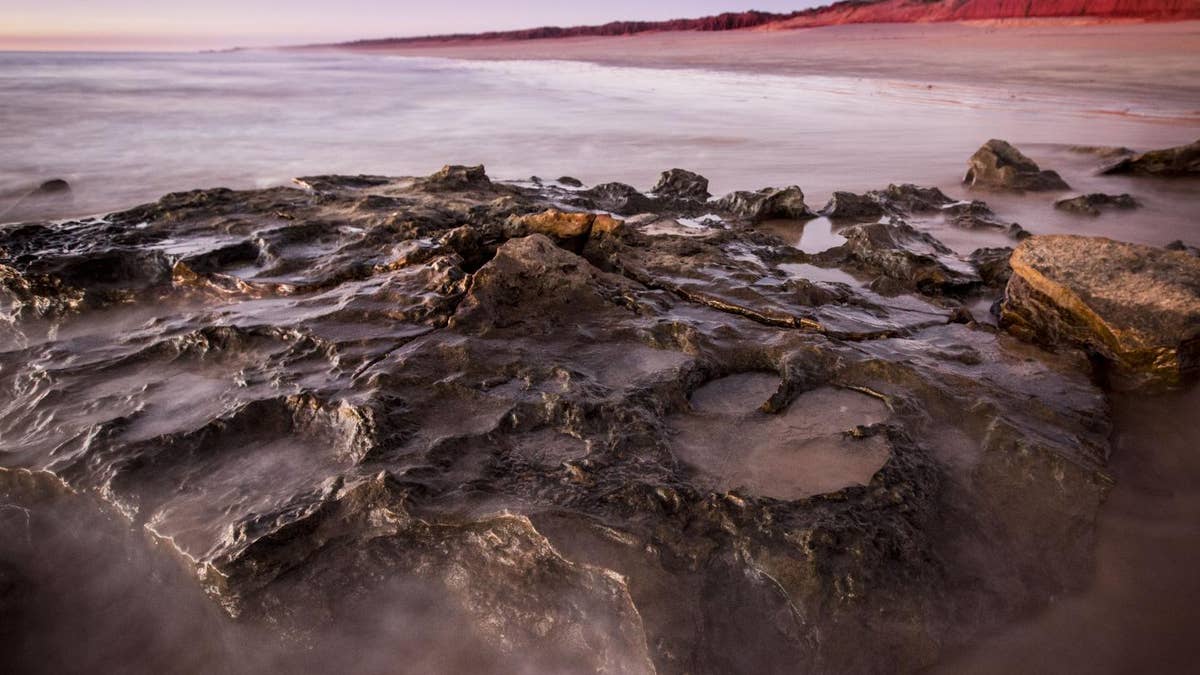
Dinosaur tracks at "Australia's Jurassic Park." (Damian Kelly)
Scientists have discovered the world’s largest footprint in a stretch of remote coastline known as “Australia’s Jurassic Park”.
The unidentified sauropod’s print is 5 feet, 5 inches long.
The Walmadany area is home to the world's largest dinosaur tracks. Law Boss Richard Hunter and a 1.7m sauropod track https://t.co/B3NAlwBreD pic.twitter.com/X2Ii5GiC7u
— Steve Salisbury (@implexidens) March 27, 2017
It was found among an "unprecedented" 21 different types of dinosaur tracks and dwarfs a meter-long footprint discovered in the Gobi desert by a team of Japanese and Mongolian researchers.
Palaeontologists from the University of Queensland and James Cook University said their find was the most diverse array of dino footprints in the world.
'KING' POLAR BEAR SKULL FOUND IN NORTHERN ALASKA MAY SOLVE MYSTERY
The remains were unearthed in rocks aged up to 140 millions years old in the Kimberley region of Western Australia.
More from The Sun
Steve Salisbury, lead author of a paper on the findings published in the Memoir of the Society of Vertebrate Paleontology, said the tracks were "globally unparalleled".
He added: "It is extremely significant, forming the primary record of non-avian dinosaurs in the western half of the continent and providing the only glimpse of Australia's dinosaur fauna during the first half of the Early Cretaceous Period.
"It's such a magical place -- Australia's own Jurassic Park, in a spectacular wilderness setting."
He added: "Among the tracks is the only confirmed evidence for stegosaurus in Australia. There are also some of the largest dinosaur tracks ever recorded."
Our monograph on the dinosaurian tracks of Walmadany is now out as the 2016 SVP Memoir. Photo: Damian Kelly https://t.co/B3NAlwBreD pic.twitter.com/89hHSWidc4
— Steve Salisbury (@implexidens) March 27, 2017
It was almost lost, with the Western Australian government in 2008 selecting the area as the preferred site for a massive liquid natural gas processing precinct.
ANCIENT EGYPTIAN STATUE LIKELY NOT RAMSES II, OFFICIAL SAYS
The region's traditional Aboriginal custodians, the Goolarabooloo people, contacted Salisbury and his team to officially research what they knew was there.
They spent more than 400 hours investigating and documenting dinosaur tracks in the Walmadany area.
The area was eventually awarded National Heritage status in 2011 and the gas project subsequently collapsed.
Salisbury said: "There are thousands of tracks around Walmadany. Of these, 150 can confidently be assigned to 21 specific track types, representing four main groups of dinosaurs.
"There were five different types of predatory dinosaur tracks, at least six types of tracks from long-necked herbivorous sauropods, four types of tracks from two-legged herbivorous ornithopods, and six types of tracks from armored dinosaurs."
Most of Australia's dinosaur fossils have previously come from the eastern side of the vast country.
Earlier this year, scientists discovered the remains of a flesh-eating dinosaur the size of an airplane.
